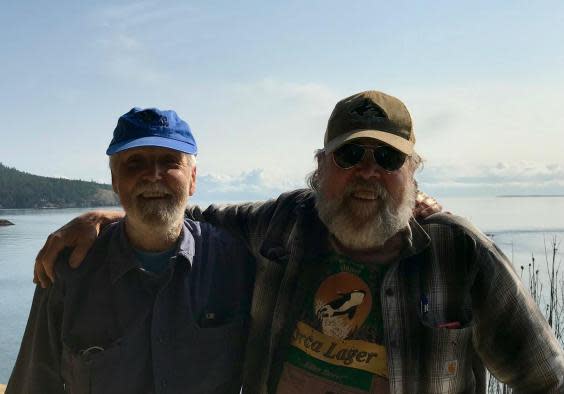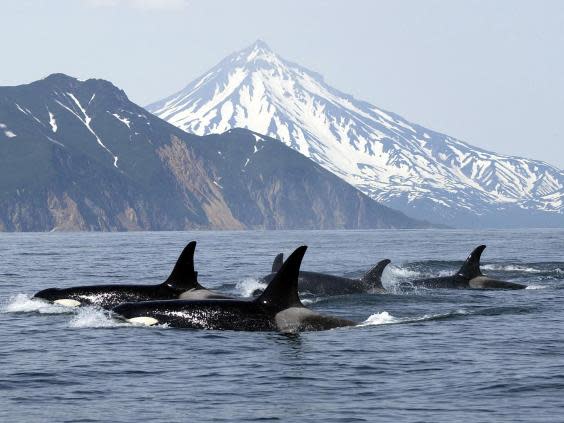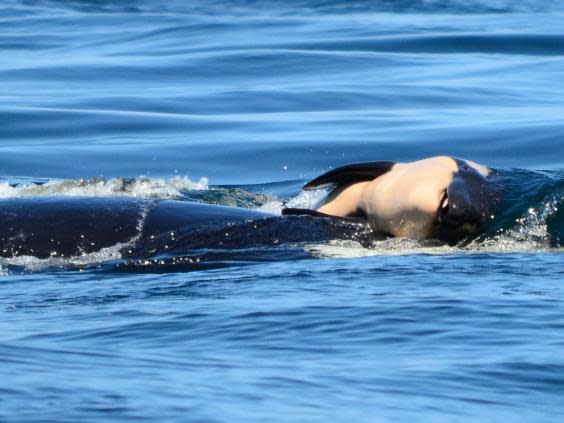The killer whales of the Puget Sound are dying out and we can't save them
It’s like the sound of a large piece of wood being smacked hard on to water. Not the sharp, narrow crack of a rifle, but something heavier, flatter. Howard Garrett immediately knows what it is.
“That’s a whale,” he says, hurrying to the balcony. “It was slapping its tail. And those are blows – exhalations. There are several. Those blows had different sounds.” For the past four decades, Garrett has been monitoring the killer whales of the Puget Sound with rare intensity. He and his half-brother, Ken Balcomb, are among scores of naturalists, some paid, most volunteers, who track the precise movement of the creatures on a daily, or even hourly, basis.
They have assigned them numbers, plotted matrilineal relationships of different pods, mourned the death of an individual, and celebrated that most glorious rarity – the successful birth of a new calf.
And over this time, they have come to a disturbing conclusion – that the resident killer whales, or orcas, of the southern Puget Sound are doomed, and there is virtually no way to save them.
“The crisis is huge. They are virtually on the brink of extinction by not reproducing,” says Balcomb, who has run the Centre for Whale Research on Washington’s San Juan Island since 1976. “You have to have babies to survive, and for the last two or three years in a row we’ve had no babies, or no survivable babies. So…”
Twenty years ago, this population of orcas numbered 100; today there are as few as 75, the least for at least 30 years. In the spring of 2018, Democratic governor Jay Inslee established a task force to find solutions and announced $1.1bn to help the whales and the fish they rely on.
“We are undertaking a herculean effort to save these iconic creatures. It will take action at every level of the environment across our entire state,” says Inslee, who has since announced a presidential run, seeking to highlight threats to the environment.
The killer whales – Latin name Orcinus orca – that are so at risk, are an ecotype known as the southern resident orcas. Unlike the Biggs, or resident orcas, which range further and catch other mammals such as seals, the resident orcas are fussy eaters.
They feed only on salmon, specifically the large high-fat chinook salmon, which travel thousands of miles into the oceans before returning to their home streams to spawn and die.
The chinook of the waters off Seattle have long been under pressure from overfishing, the construction of dams and pollution. Their numbers have fallen, and their average size sharply reduced. That fall has coincided with the reduction in size of the southern resident orcas, which were listed as endangered in 2005.

(Up until 1976, when the state of Washington enacted a ban, companies such as SeaWorld used aircraft and explosives to capture the killer whales for their parks and aquariums. There is a campaign to free those creatures still in captivity.)
To the north of the Puget Sound, where there are fewer people and less pollution, pressure on the chinook is less intense. The result is that the population of orcas off the coast of British Columbia, Canada, stand at 309 and are increasing by 3 per cent a year.
“Their environment has changed so quickly, over just two generations,” Sheila Thornton, senior killer whale biologist for Canada’s department of fisheries and oceans, told The Seattle Times, of the southern group, which is organised by scientists in three pods – J, K and L. “To keep up with these changes is almost an impossible task.”
Tahlequah
On occasion, the travails of the southern resident orcas, the most studied killer whales in the world, play out in public tragedy.
Last summer, a 20-year-old female, number J35, but better known as Tahlequah, gave birth to a calf, the first by any of the group for a number of years. For a brief period, the calf was observed swimming healthily alongside its mother, but shortly afterwards it was seen to have died.
Only 75
Southern resident killer whales left in the wild
For the next 17 days, and over the course of thousands of miles, Tahlequah refused to let go of its calf, pushing it with her head on what some termed a “tour of grief”.
The mother’s dedication to its child became a media spectacle. The events were watched with horror by people around the world, and monitored constantly by those in the Pacific northwest before, eventually, Tahlequah let the body of its calf fall into the ocean.
“They are wild animals, but their obvious grief and pain seem relatable to most of us,” says Miyoko Sakashita, director of the oceans programme at the Centre for Biological Diversity, which has filed a lawsuit seeking to force the Trump administration to enlarge habitat protections for the orcas.
“Despite our love for these iconic orcas, human activities are what’s driving them towards extinction.”
Intelligence
Ask any killer whale obsessive what it is they so love about the orcas, and pretty soon they bring up the creatures’ intelligence.
The animals, which have a life cycle not entirely dissimilar to humans and can live to be as old as 80, develop tight family bonds, and friendships that can last decades. The oldest of the southern resident orcas, a female, is estimated to have been born in 1928.
Research led by John Ford in the 1980s identified 26 different calls specific to the southern residents alone. This ecotype does not breed with the northern population, and genetic research suggests the southern residents last shared a common ancestor with the transient orcas 700,000 years ago.
“It’s not just the way the whales relate to each other, or the way they catch food, there is definitely somebody at home there,” says naturalist Katie Jones, who has been studying the whales since 2001, and staffs the research centre’s public education office in the port of Friday Harbour.
“It’s hard to quantify. I think that we as humans, we can’t fully understand the intelligence of these animals.”
On the ferry
One recent weekend morning, The Independent collected Garrett from his home on Whidbey Island, west of Seattle, drove an hour north and caught the ferry from Anacortes to Friday Harbour, located on the largest of the San Juan islands. At the stern of the ship tourists and commuters watch as the white and green painted MV Hyak ploughs through quiet waters, passing forested islands. From time to time, gulls hover and trail.
Inside, away from the wind, the 74-year-old Garrett describes a life of adventure and travel, that eventually led him to reconnect with Balcomb and return to the region. While Balcomb only lived on the neighbouring island, they did not meet that frequently, though they communicated every day.
Garrett, who has a degree in sociology, says he was especially interested in the animals’ relationships with each other. “Orcas are culturally the closest to humans.”

He says the problems confronting the animals involve too many big interests – the hydropower industry reliant on the dams that block the rivers and interfere with salmon migration, the commercial shipping industry, and pollution that seeps into the water.
This would only become worse if a deal between the government of Canada and infrastructure giant Kinder Morgan to expand the Trans Mountain Pipeline goes ahead. Estimates suggest the amount of oil tanker traffic in the Puget Sound area could increase seven-fold.
Last summer, the planned expansion was halted by an appeals court in Canada, which said the project had not consulted sufficiently with indigenous or First Nation Canadians. The judge also said the project had failed to provide a sufficiently comprehensive environmental impact assessment about how increased tanker traffic would affect the orcas.
Other challenges, such as persuading whale watching boats to reduce speeds and maintain a greater distance from the animals, was easier to control. “The whale watching industry is not what’s killing these whales,” says Garrett, who runs his own group on Whidbey Island, Orca Network.
Garrett’s brother, a genial 78-year-old, is something of a legend among the whale science community. With several marriages or relationships wrecked by his dedication to the animals, he has amassed an unrivalled amount of data – in the form of photographs, video and logbooks – about the southern resident orcas. Indeed, it was his constant photographing of the animals, which started in 1976, that allowed others to painstakingly sift through and spot natural markers on the animals to identify them.
What would it take to save these whales? A complete change in our paradigm about how we manage fisheries, how we deal with ecology and ecosystems. There’s still something alive here, but we’re failing it. It’s going downhill while everyone’s having meetings and conference calls
Ken Balcomb
He is also celebrated for his role in a famous legal victory. In 2000, Balcomb, a former member of the navy, was in the Bahamas when he and Diana Claridge, his fourth wife, discovered around 20 beached beaked whales. Many had bleeding ears, and the couple collected tissue samples from six dead animals.
The navy investigated and concluded its use of sonar may have led to the beachings. After a lengthy legal battle, the Ninth US Circuit Court of Appeals, banned the navy from using mid-frequency active sonar and explosives in training exercises in specific waters around California and Hawaii where whales are known to frequent. The story is told in Joshua Horowitz’s War of the Whales.
“I first saw this place in 1977,” Balcomb says of the property overlooking the Salish Sea that is now the centre’s headquarters. “I used to get calls from people when they spotted a whale, and most of the calls came from the woman who lived here. When I came to visit, I understood why.”
Balcomb starting renting the property that overlooks one of the busiest killer whale routes in the world. For years, much of his work was supplemented by volunteers, from groups such as the Earthwatch Institute, who would spend summer months camping in the grounds of the house, spending their days watchin, going out by boats for a close-up of the whales or monitoring them from the balcony deck with binoculars or telescopes.
What was then the office has now been converted into Balcomb’s home and archive. The west-facing front room has a vast window looking out to sea. Among his possessions is a white grand piano. Balcomb cannot play, but he has the instrument regularly tuned, for any visitors who can.
Everything you want them to be
Among the volunteers who came and never left was Dave Ellifrit, 51, originally from a small town in Missouri, where, as he puts it, “there are no whales”. He says he was first shown a picture of a killer whale at the age of three.
As a teenager, he became increasingly obsessed, especially the southern resident orcas. He studied Balcomb’s photographs that were used to identify the whales. Nobody, he assumed, would be permitted to volunteer at the centre if they could not immediately distinguish J17 from L87 simply from looking at their dorsal fins.
As it was, not everyone had Ellifrit’s level of dedication or skill. He stayed on, eventually becoming a member of staff and compiling logs of daily sightings, accompanied by photographs. Today, he refers to the animals with a warm intimacy.

A veteran of thousands of “whale encounters”, he talks almost dreamily of them. “They’re one of the coolest looking things I’ve ever seen. There’s something intriguing about something that big, that powerful,” he says.
“The whales are just great. They’re everything you want them to be.”
The sound of the slapping brings people to their feet. A message passed on from someone down the coast suggests the whales, having set out for the Pacific earlier in the day, have “flipped” and are returning to the Salish Sea.
Steadily, in small groups, they make their way northwards, breaking surface to air, a mile or so from shore. They are visible with the naked eye, but with binoculars or a telescope, you can see their progress much more easily – ink black skin amongst the shimmering blue.
Ellifrit and Balcomb rush to photograph and video the animals. Just from sight, they are to identify them as members of J pod – J17, J37, J46 and J49.
As they watch, the men become passionate about the whales, their future and the obstacles blocking the changes that could ensure their survival.
Garrett has called for a radical step – the removal of up to four dams on the Snake River in neighbouring Idaho, once a thriving habitat for Chinook salmon. He says the dams are no longer needed for electricity, transportation or irrigation. He claims the removal need not be costly or bureaucratic; the Army Corps of Engineers, which maintains the dams, has it in its power to remove them without the need for a new finding under the National Environmental Policy Act.
“The historically most bountiful high-altitude orca-sustaining wild salmon in the world are being driven to the brink of extenuation because of the dams,” he says. Elsewhere in the region, where dams have been removed and rivers “rewilded”, naturalists have seen nature respond quickly.
The task force established by Inslee recommends boosting chinook supplies, reducing disturbance from shipping and reducing the “ever-increasing mixture of pollutants in the marine environment”. It also wants to restrict the number of whale watching boats, which are one of the few businesses on the islands.
Balcomb, a task force member, questions some of its recommendations, including the increased use of hatcheries to restore fish stocks. He says there is a danger, as the report acknowledges, to the integrity of the wild salmon. He also disagrees with the decision to limit whale watching boats. The real problem, he says, is not small boats, but a lack of political will to take on powerful interests.
“What would it take to save these whales? A complete change in our paradigm about how we manage fisheries, how we deal with ecology and ecosystems,” he says. “There’s still something alive here, but we’re failing it. It’s going downhill while everyone’s having meetings and conference calls.”
January
On the evening of 10 January, people watching Seattle’s KING 5 evening news were treated to a special sight – more than a dozen whales swimming together in the Puget Sound, between West Seattle and Vashon Island. The footage was captured by one of the network’s helicopters, and showed one of the largest groups of whales seen together for years.
What the news team did not realise, until it was pointed out by one of the many naturalists watching, was that the cameras had captured something even more startling – evidence of a new calf, swimming alongside its mother.
The next day, Balcomb and others confirmed the news. They estimated the calf had been born to L77, whose pod had not given birth to a new calf since 2015, and was just a few weeks old. It has has already been given a number: L124.
Garrett was among those who spotted the new family member on the evening news. His eyes shine when he remembers the January “get-together”, when the whales swam together, perhaps welcoming the newborn calf. “That was something else. That was amazing.”

